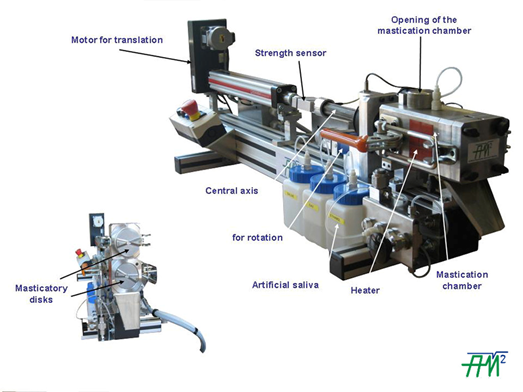Artificial Mastication Advanced Machine (AM2)
About us
During food oral processing the food is changed into a bolus suitable for swallowing and for assimilation. This first step of digestion act definitely on the ability of a given individual to consume a given food.
The major role of mastication consists in transforming food into a bolus to be swallowed. This is done through the mechanical reduction of the food into small particles. This reduction is associated with the lubrication of the food fragments by saliva and by the fluids liberated by the degrading food. The resulting bolus is a cohesive and viscous mixture whose elements stick together, but not to the oral mucosa. Thus the bolus can gently glide against the pharynx walls during the swallowing process while preventing particles from going through the trachea. The formation of the bolus during mastication implies the occurrence of various processes that are not only mechanical, but also chemical and enzymatic.
The main mastication parameters allowing the adaptation to the food texture are the force generated by the mastication muscles, the number of cycles (number of bites), the length of the mastication sequence (from the moment the food is put into the mouth to when it is swallowed) or still the mastication rate (rhythm). The technology we used most certainly makes the AM2 a simple and robust machine while allowing the simulation and adjustment of the main mastication parameters.
The AM2 Inventors are Pr Alain Woda (PHD), Marie Agnès Peyron (PHD), Anne Mishellany (PHD), Olivier François (Eng.), Monique Alric (PHD) & Lionel Batier (PHD).
The major role of mastication consists in transforming food into a bolus to be swallowed. This is done through the mechanical reduction of the food into small particles. This reduction is associated with the lubrication of the food fragments by saliva and by the fluids liberated by the degrading food. The resulting bolus is a cohesive and viscous mixture whose elements stick together, but not to the oral mucosa. Thus the bolus can gently glide against the pharynx walls during the swallowing process while preventing particles from going through the trachea. The formation of the bolus during mastication implies the occurrence of various processes that are not only mechanical, but also chemical and enzymatic.
The main mastication parameters allowing the adaptation to the food texture are the force generated by the mastication muscles, the number of cycles (number of bites), the length of the mastication sequence (from the moment the food is put into the mouth to when it is swallowed) or still the mastication rate (rhythm). The technology we used most certainly makes the AM2 a simple and robust machine while allowing the simulation and adjustment of the main mastication parameters.
The AM2 Inventors are Pr Alain Woda (PHD), Marie Agnès Peyron (PHD), Anne Mishellany (PHD), Olivier François (Eng.), Monique Alric (PHD) & Lionel Batier (PHD).
Our services
The platform has been developed to meet various demands from the fields of Basic Research, Pharmacy, and Animal Food, from the Medical or Dental sectors, thus allowing to dispens with the constraints inherent to in vivo studies.
- Basic Research is a sphere where the use of AM2 is most appropriate and can bring a lot of information when studying the physiology of mastication in a target population or in the field of nutriotional research for example. Indeed controlling the different mastication parameters allows us to assess the consequences of various factors on the formation of the bolus (teeth or no teeth, saliva, muscular forces simulating various populations... Collecting the whole bolus after mastication by AM2, together with the addition of artificial saliva, is a major asset when analyzing the physical-chemical characteristics of the bolus, at any time. Lastly it is possible to carry out nutritional studies since the collection of the bolus and the released liquids allows us to analyze the components of nutritional interest.
- Farm-produce compagnies must meet the consumer's demands, that is they must vouch for the sanitary, sensory and dietary qualities of the produce. The development of new produce requires the joint optimization of both organoleptic (texture, colour, flavour, ...) and nutritional qualities. The use of AM2 can for instance provide the farm-produce industry with solutions to expand its current strategy to develop new produce. AM2 can indeed contribute to a better knowledge of mechanical degradation, of the structural modifications of food in the mouth. This information can make it easier to adapt the texture and the food to the nutritional needs and the physiological capacities of the target population, while retaining the hedonistic quality of the food.
- The Pharmaceutical industry can be interested in the use of AM2 to assess the in-mouth performance of various galenic formulations.
- The animal food industry could also benefit from AM2 since the development of jaws specially devised for given species can prove useful to test in vitro the "masticability" and the transformation of foods.
- The medical field a better understanding of the physio-pathology of mastication in people with risk factor can be expected (edentulousness, trauma sequels, oral pathologies related to ageing or a neuro motor disorder, and all the more so to the combination of one or several of these factors). AM2 can also provide information in fields that cannot be tested through human experimentation (non-cooperating subject, bolus textures that can compromise swallowing). The concerned populations are quite numerous and the repercussions of bad mastication on the general state of health are significant and underestimated. In France for instance it is estimated that two million people are totaly edentulous and that many more are dependent.
- In the dental field it is absolutely essential to test the materials used (ceramics, resins, metals, ...) in masticating conditions. The dental arches can be fitted with tooth core on wich crown restorations can be adapted to test wear of materials for instance.
Equipments
The technology we used most certainly makes the AM2 a simple and robust machine while allowing the simulation and adjustment of the main parameters of food oral processing. This parameters are the force generated by the mastication muscles, the number of cycles (number of bites), the length of the mastication sequence (from the moment the food is put into the mouth to when it is swallowed) or still the mastication rate (rhythm).
 1. AM2 operating principle:
1. AM2 operating principle:
It is based on the confrontation of two jaws, a fixed one and a mobile one, each bearing a "dental arch". These "dental arches" have a mastication surface similar to the dental surfaces at work in human mastication. They do not reproduce human anatomy, but they have been devised to impose the same types of shear and compression constraints as those exerted in vivo. The jaws are driven by engines that are themselves automated (see animations).
2. Controlled parameters:
The parameters are controlled by computer, thus allowing the experimenter to master them. The main parameters the experimenter can select are :
4. Analysis of the bolus:
Various analyses can be performed on the mastication platform to characterize the bolus made by AM2 :

It is based on the confrontation of two jaws, a fixed one and a mobile one, each bearing a "dental arch". These "dental arches" have a mastication surface similar to the dental surfaces at work in human mastication. They do not reproduce human anatomy, but they have been devised to impose the same types of shear and compression constraints as those exerted in vivo. The jaws are driven by engines that are themselves automated (see animations).
2. Controlled parameters:
The parameters are controlled by computer, thus allowing the experimenter to master them. The main parameters the experimenter can select are :
- the type of constraints exerted on the food : shear/compression associated to the type of movements reproducing circumduction, that is the vertical and lateral movements of the lower jaw.
- The number of masticatory cycles, the cycle duration and the duration of the mastication sequence.
- The force range to be applied according to the masticated food.
- An artificial saliva whose composition can be adjusted is proposed. It is injected into the mastication chamber by means of a mechanized pump controlling its rhythm and flow.
- The mastication chamber temperature is also controlled.
3. Data acquisition:
The time course of the forces applied to the food during mastication and the mastication chamber temperature are recorded continuously. The different strategies used to adjust the mastication parameters can be stored and used again.4. Analysis of the bolus:
Various analyses can be performed on the mastication platform to characterize the bolus made by AM2 :
- granulometry of the bolus (analysis of the size or shape distribution of the particles).
- Rheological performance of the bolus (plasticity, cohesion, ...).
- Various other analyses.
Some of our achievements
- Peyron MA, Santé-Lhoutellier V, François O, Hennequin M. Oral declines and mastication deficiencies cause alteration of food bolus properties. Food Funct. 21;9: 1112-1122, 2018.
- Roger-Leroi V, Mishellany-Dutour A, Woda A, Marchand M, Peyron MA. Substantiation of an artificial saliva formulated for use in a masticatory apparatus. Odontostomatol Trop. 35: 5-14, 2012.
- Mishellany-Dutour A, Peyron MA, Croze J, François O, Hartmann C, Alric M, Woda A. Comparison of food boluses prepared in vivo and by the mastication simulator : AM2. Food Quality and Preference, 22: 326-336, 2011.
- Woda A, Mishellany-Dutour A, Batier L, François O, Meunier JP, Reynaud B, Alric M, Peyron MA. Developpment and validation of a mastication simulator. Journal of Biomechanics, 43:1667-73, 2010.
Contacts
Address
AM2 - CROC EA 4847
UFR d’Odontologie
2 rue de Braga
63000 Clermont-Ferrand, France
UFR d’Odontologie
2 rue de Braga
63000 Clermont-Ferrand, France



